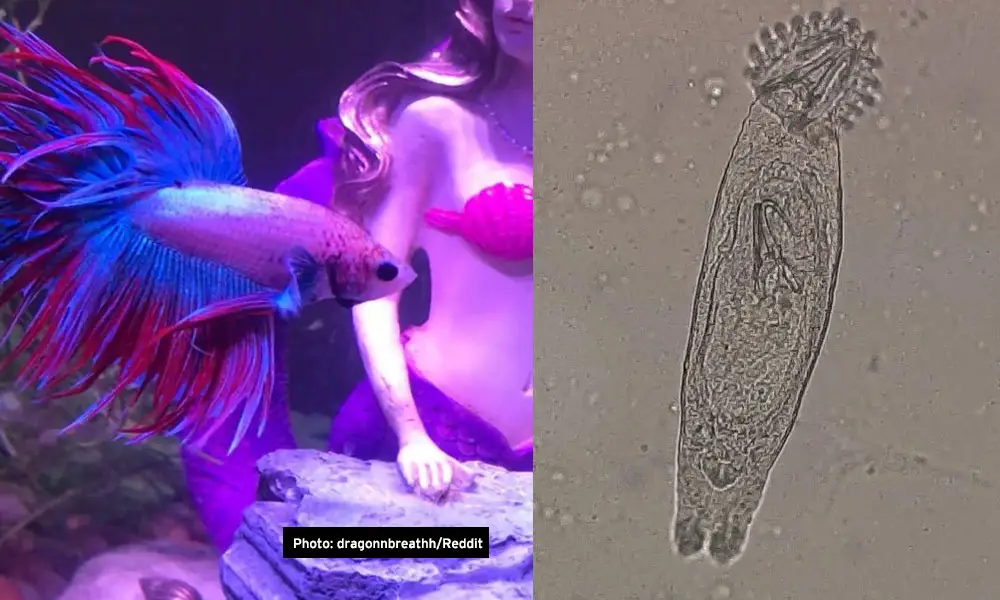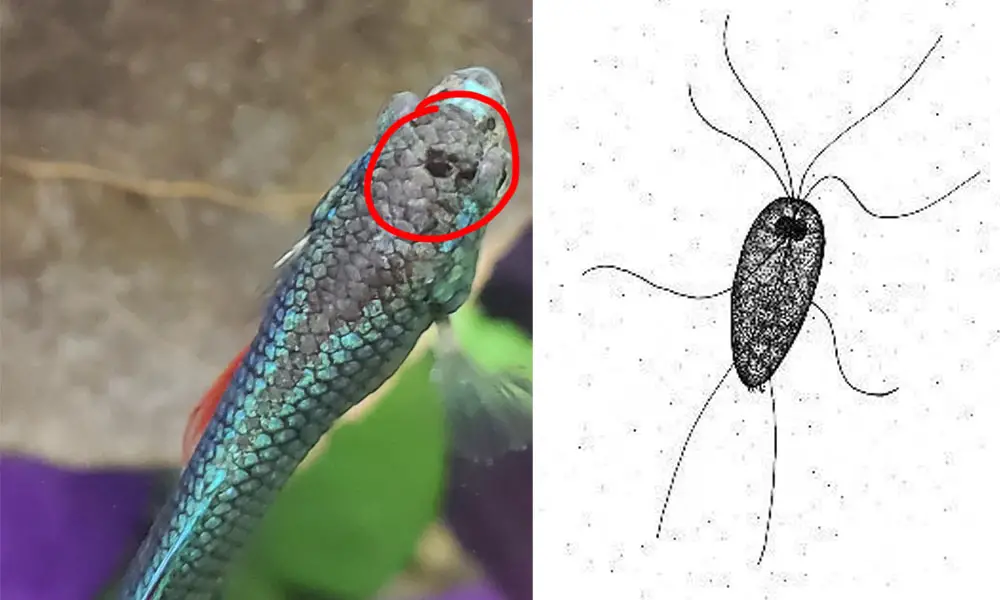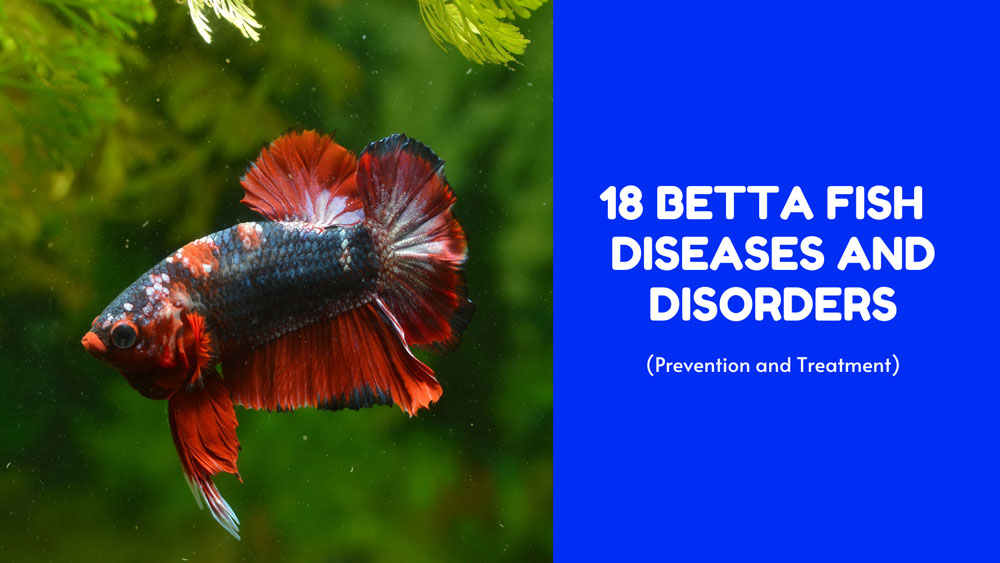Bettas are one of the most popular freshwater fish and are beloved by many aquarium hobbyists, especially novice fish owners.
Unfortunately, they don’t seem to live very long and are also prone to various diseases and disorders that can significantly reduce their expected lifespan.
The problem is that it’s not easy to catch and treat a sick betta fish if you’re new to aquariums or have never seen the illness before.
Not sure what to look out for? Read on and learn about common disorders and diseases in betta fish. We’ll help you spot the symptoms of different infections and suggest treatments to help your fishy friend stay healthy and happy.
Parasites
Nothing is more exciting than bringing your betta fish from the pet store. However, it’s the highest risk time at this point, as most parasites can travel and enter the aquarium from many outside sources.
Just like humans, a low level of parasites can be present in healthy bettas at all times, but their immune systems can keep them in check.
When a fish experience stress from various sources, including capture, shipping, poor water quality, injuries, or poor diet, the immune system becomes compromised, and parasites can quickly overpopulate in the fish’s body.
There are many different parasites that can affect your betta fish:
Ichthyophthirius multifiliis, aka White Spots on Betta Fish

Ich or white spot is caused by a large, ciliated protozoan, Ichthyophthirius multifiliis, which can cause the characteristic white spots on your betta’s gills, skin, and fins.
This external parasite has a fairly short but complex life cycle [1], making it highly contagious and difficult to treat. If left untreated, this disease may be fatal.
Cause
- Stressed environment
- Failure to quarantine your new betta
- Using infected equipment or décor
- Ich tomonts attached to a fish bag and live plants
Physical/Behavioral Symptoms
- White spots that resemble grains of salt visible on skin or fins
- Clamped fins
- Fish scratching against rocks, décor, or gravel
- Missing scales
- Fish appearing lethargic
- Rapid respiration
- Gasping at the water’s surface
- Multiple fish died suddenly
Treatment
Since there are other causes of white spots on betta fish, it’s important to properly diagnose the disease before administering treatment. Once the diagnosis is confirmed, the best course of action will be to use a commercial medication specifically designed for Ich. Hikari Ich-X, Kordon Rid Ich Plus, and Mardel Quick-Cure are all good products available on the market.
Piscinoodinium spp, aka Velvet on Betta Fish

Velvet disease in betta fish is caused by the Piscinoodinium spp., a group of external dinoflagellate parasites. It is commonly called Gold-dust or Rust disease; the name is given to the symptoms of this parasitic infection – a gold or rust-colored and velvety film that appears on the betta’s gills and skin.
Cause
- Failure to quarantine
- Stressed environment
- Using infected equipment or décor
- Ich tomonts attached to a fish bag, plants
Physical/Behavioral Symptoms
- Gold or rust-colored and velvety film on gills and body
- Color loss
- Heavy mucous secretion
- Gasping at the water’s surface
- Clamped fins
- Loss of appetite
- Labored breathing
Treatment
Two treatment options are available for Velvet in betta fish: salt baths and copper sulfate.
Salt baths are an effective and safe method, but it might take several days to complete the treatment.
Copper sulfate (CuSO4) has been used as a parasiticide for years, but it can affect the water chemistry and kill invertebrates, so follow the instructions carefully.
Lernaea spp, aka Anchor Worms on Betta Fish

Contrary to its name, anchor worms are not true worms but rather a type of crustacean parasite of aquarium and pond fish. Anchor worms or Lernaea species are external copepods that burrow into your betta’s body, gills, or mouth and anchor in the muscle tissue cavities using hook-like appendages.
A small number of anchor worms isn’t fatal, but heavy infestations can result in intense inflammation, leading to a secondary bacterial and fungal infection.
Cause
- Failure to quarantine new bettas
- Using infected equipment, live plants or décor
Physical/Behavioral Symptoms
- Visible white or yellow thread-like worms protruding from the skin, gills, fins, and oral cavity
- Oral cavity problems
- Skin patches and red lesions
- Scratching against objects in the tank
Treatment
Anchor worms can be physically moved using tweezers but be aware they may break off and leave the head in your fish. Ensure the wound must be treated with antibiotics to prevent further infestations. For more treatments on using salt or chemicals to treat anchor worms, read our blog post here: Anchor Worms in Betta Fish
Body and Gill Flukes on Betta Fish

Unlike velvet or Ich, Flukes are microscopic, parasitic flatworms and are not visible to the naked eye. These parasites get the name “flukes” from their flattened body shape as flounder fish, and “fluke” is a well-known Old Saxon name for flounder.
Interestingly, flukes seen in betta fish are similar but not the same — they belong to two genera: Dactylogyridae and Gyrodactylidae. The former, Gill flukes, are found on fish’s gills, while the latter, known as body flukes, mostly infects the betta fish’s body.
Causes
- Skipping proper quarantine
- Stressed by incompatible species
- Poor water quality
- Improper diet
- Crowding
Physical/Behavioral Symptoms
- Missing scales and red spots on the skin
- Loss of color
- Excess mucus secretion on gills or body
- Scratching against objects by the affected betta fish
- Gills moving rapidly
- Flashing behavior
- Lethargy
- Decreased appetite
Treatment
In most cases, you may want a veterinarian to diagnose this disease. One of the safest, most effective treatments for fish flukes is Praziquantel. There are many Praziquantel products, such as Hikari PraziPro or Thomas Labs Fish Tapes.
Betta with Hole in the Head (HITH)

Also known as head and lateral line erosion (HLLE), this disease is most commonly seen among discus, Oscar, and other South American cichlids but also infects bettas.
Many aquarists believe that the protozoan Hexamita spp. is responsible for this disease, but others argue that fish with HITH is a result of multiple factors or from a combination of the following problems:
Causes
- Poor water quality
- Inadequate biofiltration
- A fish infected with Mycobacterium spp. aka Fish Tuberculosis (Fish TB)
- A fish infected with Hexamita spp.
- A fish infected with Aeromonas spp.
- A fish may have a secondary bacterial infection
- Improper diet
Physical/Behavioral Symptoms
- Small pits on the head
- White, stringy feces
- Decreased appetite (Spitting food back out)
- Bloated belly
Treatment
There is no effective method to make a correct diagnosis. Making medicated diets by adding Metronidazole to fish food has been used with some success. If the betta fish has stopped eating, Metronidazole can be added directly to the aquarium.
Lice in Betta Fish aka Argulus spp.
Quite often, infections with these macroscopic parasites are found in pond fishes, particularly goldfish, koi, and other carp or minnow families. Still, Argulus spp. can occur in a betta fish tank.
The Argulus species are crustaceans with a flat shell, two compound eyes, and four free swimming legs, so they do not require a microscope to be seen. They pierce the betta’s body with a thin, needle-like stylet, leaving a wet mount of the affected tissue, which leads to severe secondary infection.
Causes
- Failure to quarantine a new fish
- Poor water quality
- Stressful conditions
Physical/Behavioral Symptoms
- Moving dots on fish
- Scratching against objects in the aquarium
- Lethargy
- Abnormal behavior
Treatment
Adult argulus can be manually removed using a hemostat. Medication, like Dimilin, is known to treat fish lice. Also, the aquarium water must be medicated to kill any eggs and to prevent further infestations.
Bacterial Infections
A bacterial infection often observed with betta fish afflicted with external parasites, physical injuries, or can also be brought on by chronic stress.
Several bacterial pathogens can infect betta fish, including Aeromonas spp.,Edwardsiella spp., Flavobacterium spp., Pseudomonas spp., and Vibrio spp. Treating bacterial infections can be tricky and will likely become more challenging in the future because:
- Without an incubator or pathological knowledge of betta fish, it is nearly impossible to identify which specific bacteria is causing the infection, as the symptoms of these bacterial infections can be similar.
- Some antibiotics can kill beneficial bacteria and disrupt your aquarium’s biological filter.
- Due to years of misuse, several bacteria have developed antibiotic-resistant strains.
- With most bacterial infections, your entire aquarium must be treated. Obviously, this would not be a problem with a small betta tank, but it could be challenging in larger female betta sorority aquariums.
Dropsy in Betta Fish
Sometimes referred to as “bloat,” dropsy is not a specific disease but a sign of a deteriorated health condition. It can be caused by a bacterial infection, parasitic infestation, or fatty liver disease.
With dropsy, the betta fish will have a swelling abdomen or pinecone-like appearance due to a buildup of fluids, giving rise to the name “pinecone disease.” Dropsy is considered one of the most severe betta fish illnesses, and in advanced stages, it is fatal.
Physical/Behavioral Symptoms
- Swollen abdomen
- Protruding scales around the swollen area
- Redness of the skin or fins
- Inflamed gills
- Bulging eyes
- Lose their appetite
- Lethargic
- Gasping at the water’s surface
- Rapid respiration
Treatment
The sooner you diagnose and treat dropsy, the better the chance of a successful recovery. Depending on the underlying cause, you may use some wide-spectrum antibiotics like Kanamycin Sulfate or Maracyn II for bacterial infections.
Betta Fish Fin and Tail Rot
Virtually all aquarium fish are susceptible to fin and tail rot, which is caused by either a gram-negative bacterial infection or fungal infection; however, fish like bettas and goldfish with long, flowing fins are more prone to this type of infection.
As the name suggests, the main clinical sign of this infection is ragged edges on the betta’s fins and tail. The edges may also appear dark or discolored as the infection spreads.
Physical/Behavioral Symptoms
- Edge of fins or tails become discolored or ragged
- Segments of fins or tails have rotted away
- Black, white, or brown spots on the fins, tail, and body.
- Reddened skin at the base of fins and tail
- Complete loss of the infected fins and/or tail
- Lethargy
Treatment
- Test your aquarium water, and look out for ammonia, nitrite, nitrate, and pH.
- Perform partial water changes of up to 30 percent. Fin or/and tail rot infections resolve on their own over time once the root cause of the stress is addressed.
- When antibiotics or medications are required, it is best to make your medicated fish food by mixing a combination of medicines to simultaneously treat bacterial and fungal infections.
Columnaris in Betta Fish
If a betta fish appears with mold-like lesions on the body, fins, or gills, it is most likely infected with the columnaris bacteria (Flavobacterium columnare [2]), one of the oldest known Gram-negative aquatic bacteria.
This highly contagious disease is commonly mistaken for a TRUE fungal infection because of the similar white or grey growth in and on the skin, mouth, or fins.
Poor water quality is the #1 cause of columnaris in betta fish. Improper environments and inadequate diet can contribute to chronic stress on their way to your aquarium.
Physical/Behavioral Symptoms
- Grey/White fuzzy patches on the skin
- Cottony-looking lesions on the mouth
- Progressive deterioration of the back
- Fin rot
Treatment
Infected betta fish can sometimes be treated successfully with Terramycin, either as a bath or directly dosed into fish food.
Betta Fish Popeye
True to its name, the pop eye disorder in betta fish is characterized by the protrusion or bulging out of one or both of the betta’s eyes.
Scientifically known as exophthalmia, popeye is usually a symptom of a disease that is caused by a bacterial or parasite infection, fish tuberculosis, injury, or gas bubble disease.
Speaking of bacterial infection, a gram-positive diplobacillus bacterium, Renibacterium (Corynebacterium) salmoninarum [3], is the main cause of popeye in betta fish.
Physical/Behavioral Symptoms
- Bulging eyes (one or both)
- Stretching in the eye socket
- Cloudy eyes
- Redness eyes
- Lethargic behavior
- Loss of appetite
- Ruptured eyeball
- Clamped fins
- Swollen body
Treatment
Luckily, betta fish with popeye, in most cases, will survive if appropriate treatment is given fast. The most important thing to do first is to treat the underlying cause.
Tuberculosis
Although most fish diseases cannot be passed to humans, one notable exception is fish tuberculosis, which is caused by Mycobacterium spp. These Gram-positive bacteria can be transmitted to humans in contact with infected fish or water through open wounds. Tuberculosis is a chronic disease since Mycobacteria may take years to fully develop [4].
Physical/Behavioral Symptoms
- Bent or curved spine
- Fin and scale loss
- Bulging eyes (exophthalmia)
- Skin lesions
- Bloating
- Lethargy
Treatment
Unfortunately, there is no cure for fish tuberculosis.
Swim Bladder Disorder
The swim bladder of a fish, aka air bladder or gas bladder, is a gas-filled organ that helps it maintain buoyancy and stability in the water. Disorders of this organ can lead to buoyancy issues, causing the fish to either float at the surface or sink to the bottom.
Swim bladder disorder (SBD) is commonly associated with poor water quality and an underlying bacterial or fungal infection, but it could also be due to kidney or digestive issues.
Physical/Behavioral Symptoms
- Swimming sideways or upside-down
- Sinking to the bottom of the tank
- Floating to the top of the tank
- Swelling belly
- Bent or curved spine
- Loss of appetite
Treatment
If you believe your betta fish has a buoyancy disorder, start by fasting it for a couple of days and examining its living conditions. Meanwhile, raise the temperature of the water to about 80°F (26.7°C) and leave it there during treatment.
After that, feed your betta with green peas, which are known to help flush out the contents in the stomach. If this doesn’t work, you might need a broad-spectrum antibiotic.
Fungal Diseases
Fungal infections refer to diseases caused by a group of fungi that require living or dead tissue for growth and reproduction. Saprolegnia spp. and Ichthyophonus hoferi are the main species of fungus known to infect aquariums or pond fish.
These fungal infections typically manifest as white cotton or furry growth on the betta’s body, mouth, fins, or gills but can also be internal. Betta fish suffering from fungal infections exhibit a variety of clinical signs, including:
Physical/Behavioral Symptoms
- At the earliest stage, you will notice light gray or white growths in/on the betta’s skin, mouth, fins, or gills.
- If left untreated, the fungus can also spread and resemble a cotton-like growth.
- The fungus will keep eating the fish’s body until the fish eventually dies.
Treatment
Unlike parasites or bacteria, fungal infections are not highly contagious. But infected fish should be treated immediately with an anti-fungal medication in a quarantine Tank, like Methylene Blue, Hikari Ich-X, and API Fungus Care.
Viral Diseases of Betta Fish
Though not as common as parasites, bacteria, or fungi, viruses still infect all types of aquarium fish. These tiny organisms invade the cells of the fish, grow and reproduce rapidly. This process leads to the destruction of host cells, resulting in various similar clinical signs and symptoms as other diseases.
There are two well-known viral diseases in fish: Lymphocystis Disease Virus (LCDV) and Viral Hemorrhagic Septicemia (VHS).
Lymphocystis Disease Virus (LCDV)
Lymphocystis disease virus in fish is small wart-like nodules on the fins, skin, or gills. As a member of the family Iridoviridae, LCDV is much less pathogenic and rarely leads to death.
So far, this disease has been found in 125 different marine (oceanic) and freshwater fish species [5], the majority of which are bony fishes that have evolved, such as cichlids, gouramies, or killifishes.
Physical/Behavioral Symptoms
- Small to moderate-sized wart-like growths on the fins, skin, or gills
- These bumps are usually white or gray but can also be other colors if they appear under pigmented areas.
- Pop-eye (exophthalmia)
- Abnormal swimming behavior and labored breathing in the late stage of the disease,
Treatment
Since the virus does not respond to antibiotics, there’s no cure for lymphocystis disease.
Viral Hemorrhagic Septicemia (VHS)
Viral hemorrhagic septicemia (VHS) is a serious, highly contagious, and fatal disease of fish. It can affect over 50 [6] species of freshwater and marine fish. Unlike LCDV, VHS is a highly contagious, often fatal disease.
Physical/Behavioral Symptoms
- Blood red blotches on the fins or skin
- Bulging eyes (“pop-eye”)
- Swollen abdomen
- Abnormal swimming behavior
- Hemorrhages in the muscle and organ tissues
Treatment
There is no treatment for viral infections like this, so most people opt to isolate the infected fish and let the virus take its natural course.
Gas Bubble Disease (GBD)
Gas bubble disease often presents as very small bubbles inside the betta’s skin, fins and eyes. Left untreated, it may cause tissue degeneration inside the fish, leading to death.
This disease commonly manifests when your tank is filled with tiny microbubbles that are usually produced by drastic water temperature changes, oxygen supersaturation (DO level >115%), or malfunctioning filters.
Physical/Behavioral Symptoms
- Visible bubbles inside the eyes
- Blindness
- Eye bulging
- Eye inflammation
- Cataract formation
- External lumps
Treatment
The first step is to determine the source of the air bubbles and immediately remove it. For more severe cases, veterinarians may choose to lance bubbles and treat the betta with antibiotics to protect the fish from further infection.
Tumors And Cancers in Betta Fish
Bettas can sometimes develop tumors or cancers, although this is very rare. These growths are usually caused by genetic mutations and appear as small, hard bumps on the betta’s body.
Be aware that some viruses can cause abnormal growths that may resemble tumors and should be taken into consideration.
Just like other living animals, some tumors are treatable, and some are not. If you notice bumps on your fish, bring it to a vet for a closer examination. There may be other parasites at play.
Wrapping Up
If you notice your betta fish acting strangely, I hope you will be able to identify the symptoms of an ill fish and treat them effectively after reading this article.
Always, prevention and proper quarantine practices are the best ways to protect your betta fish from any type of illness and disease. Regularly test your tank parameters, keep it clean, and act quickly and contact a veterinarian if you notice anything out of the ordinary.
Let’s all do our best to keep our little friends safe and healthy!
Article Sources:
- Ichthyophthirius multifiliis (White Spot) Infections in Fish [University of Florida]
- Flavobacterium Columnare [ScienceDirect]
- Renibacterium (Corynebacterium) salmoninarum Sanders and Fryer, 1980 [U.S. Department of the Interior]
- Mycobacterial Infections of Fish [Southern Regional Aquaculture Center (SRAC)]
- Lymphocystis Disease in Fish [University of Florida]
- Viral Hemorrhagic Septicemia [Lowa State University]





